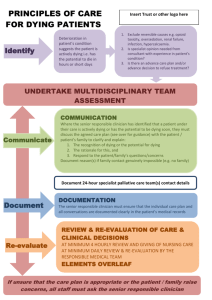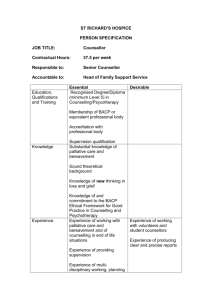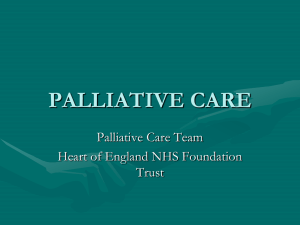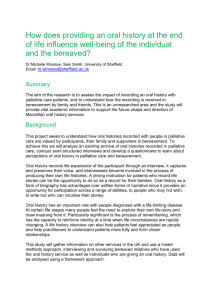SPPC Strategy 2014 - 2017 - Scottish Partnership for Palliative Care
advertisement
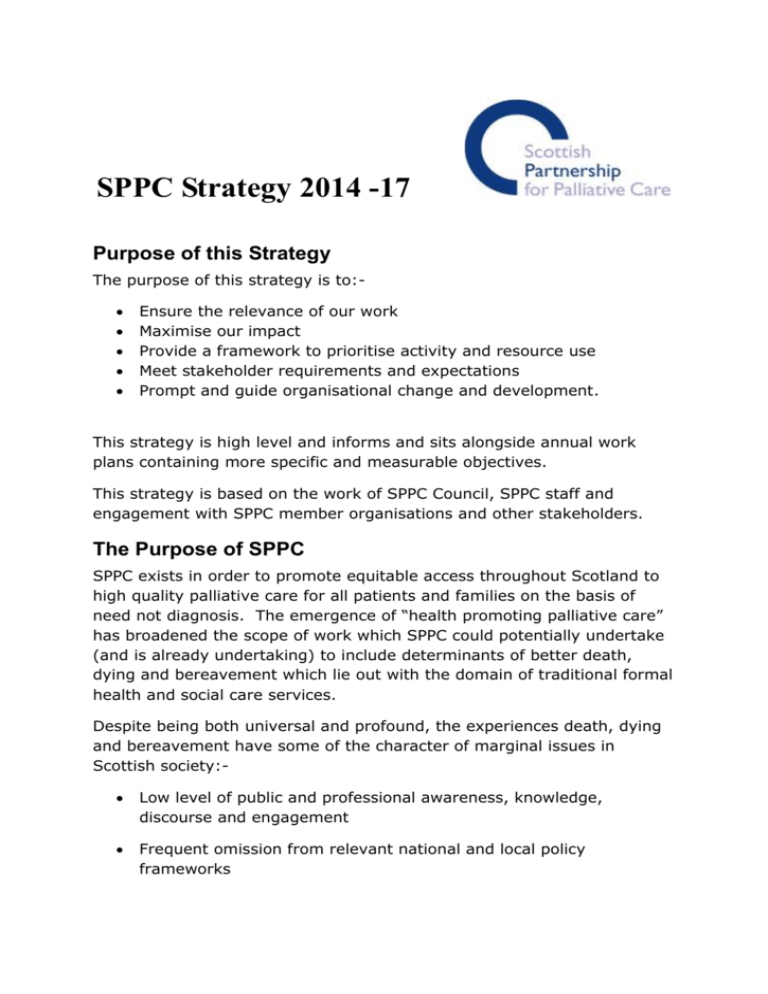
SPPC Strategy 2014 -17 Purpose of this Strategy The purpose of this strategy is to: Ensure the relevance of our work Maximise our impact Provide a framework to prioritise activity and resource use Meet stakeholder requirements and expectations Prompt and guide organisational change and development. This strategy is high level and informs and sits alongside annual work plans containing more specific and measurable objectives. This strategy is based on the work of SPPC Council, SPPC staff and engagement with SPPC member organisations and other stakeholders. The Purpose of SPPC SPPC exists in order to promote equitable access throughout Scotland to high quality palliative care for all patients and families on the basis of need not diagnosis. The emergence of “health promoting palliative care” has broadened the scope of work which SPPC could potentially undertake (and is already undertaking) to include determinants of better death, dying and bereavement which lie out with the domain of traditional formal health and social care services. Despite being both universal and profound, the experiences death, dying and bereavement have some of the character of marginal issues in Scottish society: Low level of public and professional awareness, knowledge, discourse and engagement Frequent omission from relevant national and local policy frameworks Lack of good data on the scope and performance of formal and informal services, and on the experiences of people in the final phases of life and bereavement. Our Vision Scotland will be a place where: People are able to ‘live well’ as their health declines People die well People are supported throughout bereavement. Scotland should be a place where communities and individuals are able to help each other through the hard times which can come with decline, dying, death and bereavement. People with advanced disease should experience safe, effective, person-centred care from health and social care services which understand that they can continue to make a significant difference to a person’s wellbeing even in the last months, weeks, days and hours of that person’s life. This vision can only be achieved through co-production1 by formal services, individuals and communities. Palliative care services are provided by statutory, voluntary and independent sectors and span primary to tertiary health care settings. In terms of formal services Scotland should be a place where: People live, decline and die with good control of pain and other symptoms. Health and social care staff respond quickly and appropriately to people’s physical, psychosocial and spiritual needs relating to decline, death and bereavement. Systems, processes and resources are in place within health and social care to give staff the time and support they need to exercise their skills in providing good palliative care for people and families. People die in a place of their choosing, where feasible. Co-production essentially describes a relationship between service provider and service user that draws on the knowledge, ability and resources of both to develop solutions to issues that are claimed to be successful, sustainable and cost-effective, changing the balance of power from the professional towards the service user. The approach is used in work with both individuals and communities. Scottish Co-production Network 2014. 1 2 People’s dignity is maintained as they approach death. People’s end of life care wishes are elicited and respected. To build on the assets of individuals and communities as they approach the end of their lives we also want Scotland to be a place where: Information is readily available on planning for decline, dying, death and bereavement. People have access to legal, financial and spiritual support for end of life planning (including wills, Power of Attorney, funeral arrangements). Families, communities and professions support and encourage each other to plan ahead for decline, death, dying and bereavement. People have the opportunity to discuss and plan for their decline and death with health and social care professionals. Health and social care professionals feel able to engage and initiate end of life care planning discussions with older people and their families. People have anticipatory care plans. As a result of planning and preparation people have fewer concerns about the practical, legal, financial and emotional aspects of decline, dying and death. People are in contact with the people who matter to them as they live, decline and die. Families and communities know how to help and support people at times of increased health need and in bereavement. Situation Analysis Recent Progress The 5 years since the publication of Living and Dying Well have seen high levels of commitment, activity and progress across a broad range of issues. Achievements have included: The development of the Electronic Palliative Care Summary (ePCS) to support the sharing of vital clinical information across care settings. This electronic anticipatory care plan has been further developed and widened to include all patients with long term conditions - the Key Information Summary (KIS) The development and roll out of a national integrated Do Not Attempt Cardio Pulmonary Resuscitation (DNACPR) policy across all care settings and a similar (though broader) process exists for 3 children (Children and Young Peoples Acute Deterioration Management Plan [CYPADM]) The implementation of a national incentive system to encourage in primary care the identification of people with palliative care needs and planning to meet those needs. Improvements in palliative care in care homes through educational support from hospices and NHS Boards. Agreement of national referral criteria for specialist palliative care. The development of national clinical guidelines to support the practice of generalists. The development of rapid discharge services. Development and delivery of educational supports. The development and piloting of a “Structured Scottish Response” (SSR) to the care of patients in hospital whose condition is deteriorating and whose recovery is uncertain, which prompts appropriate communication and planning with patient and family. Improvements in professional knowledge and awareness of care in the last days and hours, through educational activities associated with the LCP. The establishment of an alliance to promote more openness in Scottish society about death, dying and bereavement www.goodlifedeathgrief.org.uk . The development of local services directories and the creation of the national Palliative Care zone for patients and families on the NHS Inform portal. Future Challenges/Problems/Opportunities Given the ambition of Living and Dying Well it should be no surprise that there remains much to be done. In addition Living & Dying Well focussed largely on health care services, and not wider determinants of experience, which remain largely unaddressed. Financial and demographic pressures make this work both more urgent and more also more challenging. Future challenges include:- 4 Consolidating the Achievements of Living and Dying Well Many of the initiatives of Living and Dying Well require to be fully and robustly implemented and embedded and so that their full potential can be realised (e.g. ePCS, national DNACPR policy, CYPADM, advance and anticipatory care planning). To sustain and progress change requires ongoing investment in education and training. Staff need to work in environments which allow the time and support they need to exercise their skills in providing good palliative and end of life care for people and families. There are opportunities to ensure that palliative care is well embedded in other work streams for example the Scottish Patient Safety Programme and the national Person Centred Health & Care Programme. Palliative care priorities must continue to inform and shape the improvement of the eHealth system in Scotland to ensure that any information which reflects a patient’s wishes and end of life care priorities is accessible wherever and whenever the patient’s care is happening. Developing Approaches for Diseases other than Cancer Recent research,i debated in the Parliament, from Edinburgh University, NHS Lothian and Marie Curie highlighted suggests that only 20% of noncancer patients in Scotland are receiving palliative care before dying. Most patients in the study were identified for palliative care too late to fully benefit – on average only eight weeks before dying. GPs said that introducing palliative care was fairly straight forward for those with cancer, who typically had a clear terminal decline but much more difficult for patients with other life-threatening illnesses. Both patients and health professionals struggled with understanding of end-of-life/palliative phrases, further confusing the issue. Changing demographics necessitate effective responses to the needs of frail elderly people with multimorbidities. Improving Public and Professional Understanding of Palliative care As the aforementioned study highlights, misconceptions about palliative care remain widespread – that it is only terminal care or only care for cancer or only that care which is provided by specialist services such as hospices. A New Approach to Care in the Last Days and Hours of Life The recently announced withdrawal of the Liverpool Care Pathway creates a challenge to develop a new approach to improving care in the last days and hours of life, which builds on past progress and ensures public trust and confidence. 5 Health and Social Care Integration and the Wider Public Service Reform Agenda Financial and demographic pressures are driving reforms which include but also extend far beyond health and social care integration. The Christie Commission articulated a case for radical change. Those responsible for identifying and setting palliative care priorities need to understand the direction and nature of these reforms, considering risks and taking advantage of opportunities. Measurement of Change and Improvement It is important to be able to evidence change and improvement but there are unique challenges in measuring the impact of palliative care. Tackling the Lack of Openness About Death, Dying and Bereavement in Scottish Culture It is not currently part of Scottish culture to talk about death, dying and bereavement. This inhibits identification of people who have palliative care needs. An absence of discussion between patients and professionals means that preferences for care are not identified, documented and planned for, and outcomes are less good. From the public’s perspective this may result in care which is not person-centred. From the NHS perspective this can lead to inappropriate and costly hospital admission. . Public misunderstandings and misperceptions continue to exist about the reality of medical treatment success in the face of chronic and life-limiting illness. These misunderstandings and misperceptions sometimes extend to, and can be amplified by, elements of the media and it is important to engage with these institutions. At times of crisis the fear of a death is often eclipsed by unrealistic expectations of what today’s medical interventions can achieve and this can inhibit timely and open discussions about end of life care choices. Out with the domain of formal services the lack of openness inhibits planning by individuals, for example making wills, powers of attorney, funeral plans and advance directives. A lack of openness can also inhibit informal support by individuals and communities:- people are not well informed about a topic which is never discussed and are sometimes anxious about saying the wrong thing and making things worse. This lack of openness can impact at institutional level too; there are surprising examples of policies and reports which omit to acknowledge the fact or relevance of death, dying and bereavement, despite its universality, inevitability and impact. Taken together individual, institutional and societal lack of openness are perhaps the greatest barrier to improving people’s experience of death, dying and 6 bereavement and provide the strong rationale for further developing the work of Good Life, Good Death, Good Grief. Articulating a Clear Coherent Vision for Change Palliative and end of life care is complex, multi-faceted and works in sensitive territory. A clear vision for change needs to be developed and articulated which engages and inspires stakeholders (both professional and public) during the next phase of development. Such a vision, and an associated strategic framework for action, should be broad in conception including but moving beyond the health service focus of Living and Dying Well. Strategic Priorities for SPPC The scale, scope, and complexity of necessary change, across sectors, and involving cultural, attitudinal and behavioural dimensions as well as changes to systems and processes presents huge challenges. The task of this strategy is to identify how the very small financial, employee and volunteer resources of the SPPC can best be utilised in this context. During engagement stakeholders often articulated priorities in terms of care settings. Many stakeholders identified hospitals as a priority setting. Others identified care homes, and others argued that an emphasis should be given to community settings more generally. All made strong arguments, to the extent that it became clear that using settings as a structure for setting priorities was not very helpful. The Rationale for SPPC Strategic Priorities SPPC’s strategic priorities have been selected on the basis of the degree to which they meet the following criteria: Relevant to the purpose of SPPC and address the challenges identified in the preceding section National/strategic impact and benefit Impact across settings and on different demographics Within the competence/capacity of SPPC (including that of collaborations catalysed/brokered by SPPC) Demonstrable impact Not obviously work which should/could be more appropriately led by other (generally better resourced) organisations. 7 Six Strategic Priorities for SPPC 2014-17 OBJECTIVE 1 SPPC will provide strategic leadership in improving the experience of death, dying and bereavement in Scotland. By this we mean; maintaining a whole system perspective and associated intelligence; advocating the importance and value of palliative and end of life care; contributing to the development of strategic thinking and national policy and brokering strategic collaboration. Brief Rationale This work helps to shape the context within which improvements can take place. What Will Count as Success? SPPC will be the authoritative source of information on palliative and end of life care in Scotland. There will be a clear national strategy for improving the experience of death, dying and bereavement in Scotland. Other national policies will reflect death, dying, bereavement and palliative and end of life care when relevant. OBJECTIVE 2 SPPC will identify, and support the spread of, good practice and innovation. Brief Rationale Solutions to shared problems often exist but are not known about and/or adopted. What Will Success Look Like Service providers in Scotland will be well informed about good practice and innovation, leading to more rapid adoption/spread. OBJECTIVE 3 SPPC will promote public and professional awareness, understanding and knowledge of ways to improve death, dying and bereavement, and will promote public dialogue around these issues. Brief Rationale Better public and professional understanding, awareness and knowledge is a pre-requisite for achieving SPPC’s vision, and underpins most of our 8 work. What constitutes better death, dying and bereavement are questions for the whole of society and the appropriate mode is to encourage discussion. What Will Success Look Like There will be shifts in public attitudes survey data on issues relating to death, dying and bereavement. The media will frequently cover issues relating to better death, dying and bereavement. Death, dying and bereavement will feature on the agendas of generalist health and social care institutions. OBJECTIVE 4 SPPC will encourage effective planning for better death, dying and bereavement by the public, and by professionals together with patients and families, at all stages of life. Brief Rationale Planning, on average, improves outcomes. What Will Success Look Like Survey data will report that more members of the public have discussed and planned for end of life issues. More wills and POAs will be being made. More good quality ACPs will exist. SSR will reliably trigger ACP in all acute settings. DNACPR and CYPADM will be more widely and better used. Planning of good care in the last days and hours of life will happen consistently and reliably in all settings. OBJECTIVE 5 SPPC will work to ensure that the experiences of the public, patients and families inform the development and implementation of policy and practice. Brief Rationale Co-production requires that the experiences of the public, patients and families are heard and engaged with. The experience of care is a vital outcome which should be measured so that it informs and drives change. 9 What Will Success Look Like Stories and data will be available which paint an influential picture of the quality of death, dying and bereavement in Scotland. OBJECTIVE 6 SPPC will undertake any necessary organisational change/development necessary to deliver its strategic objectives. Brief Rationale SPPC needs to remain fit for purpose. What Will Success Look Like Success will be evident in progress on work plans and strategic priorities. SPPC will be viewed positively by members and other stakeholders. i Zheng L, Finucane AM, Oxenham D, McLoughlin P, McCutcheon H, Murray SA. How good is primary care at identifying patients who need palliative care? A mixed-methods study. European Journal of Palliative Care 2013; 20: 216–222. 10
